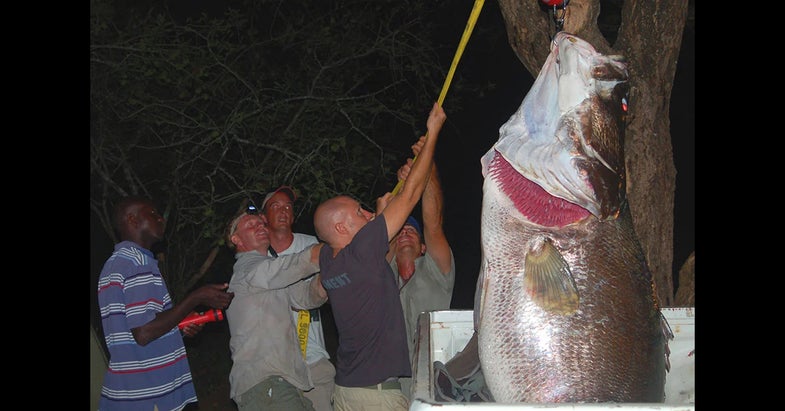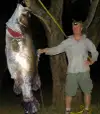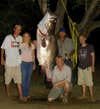Man vs. Crocodile vs. Giant Nile Perch: A Classic African Fishing Adventure
British fisherman Tim Smith faced off with a 249-pound Nile perch in 2017. He landed the river monster despite a harrowing crocodile attack

When you mention perch to Americans, most of us think of the small, feisty panfish native to our Northern waters: fun on light tackle and delicious on the table, but a bit lacking in the size department. Mention perch to those who have fished in Africa, however, and you’ll get a very different reaction. In Africa, perch fishing means swift, dark water, man-eating crocs, hippos, and Nile perch, a fish that routinely outweighs the men who pursue it.
Nile perch, which swim in lakes and river systems throughout Africa, are one of the largest freshwater fish in the world. They are popular targets for European anglers, and in 2017, British fisherman Tim Smith traveled to Uganda’s Murchison Falls on the Nile River, hoping to catch—and release—a trophy.
Recent F&S articles about giant, unusual fish, like the massive ocean sunfish a paddleboarder encountered in California or the 100-pound “moonfish” that washed up on an Oregon shore, have been big hits with our readers—for good reason. After all, who doesn’t like looking at photos of and reading about strange river and ocean monsters?
Well, here’s one of the wildest fishing stories in F&S history—how Smith caught the fish of his dreams but nearly lost his life in the process.
The Trip Begins At Murchison Falls

Smith arrived at Murchison Falls on August 16th. This was his third trip in the past few weeks. He had caught good fish on his previous trips, including Nile perch to sixty pounds, but had lost his four best to mistakes, fast water and equipment failure. He was hoping this trip would produce something bigger.
“You only get one chance with a big perch in fast water below the falls at Murchison. Either stop them before they reach the current, or hope you can bring them back on a reverse eddy – a chancy business. You need lots of line on the spool. And nerves of steel. One cut my line on a sharp rock. One broke a split ring and pulled the hook off the lure. Another shook a 9/0 hook out of its bottom lip right in front of me. The last broke new 35-pound-test mono 70 meters from the hook, somehow. It only takes a moment of carelessness — over-tightening your clutch at the wrong moment, or a small weakness in your tackle – and you’ll lose your fish.”

On the first day of his final trip, Smith launched a small boat into the river and headed toward one of his favorite holes.
“My first stop was for baitfish, on a sharp bend in the river just up from the wide slow reaches near Paraa Lodge. I tied up to a bank of papyrus and began fishing sweet corn on a waggler float. The water was colored and cloudy, which was never a good sign, but it was relaxing to sit under the sunshade and there was plenty to look at; hippos wallowing in the shallows, motionless crocodiles warming on the banks and birds all around: displaying fish eagles, kingfishers, brightly colored bee-eaters flitting in and out of burrows in the sand cliffs.”

“I worked my way upstream and finally hooked a silver ngara, a herring-like fish we prize as bait. I anchored up about ten yards from the bank it out into the current. I was fishing with a 10/0 circle hook on 100-pound-test Suffix leader with a 1-ounce rubber-core sinker. I didn’t have to wait long until my baitrunner started to shoot out line. I clicked off the runner I waited for the line to tighten, then bent the rod and set the hook! But the line stayed slack. After reeling in I found only the head of the bait fish, neatly snipped off behind the gills. Probably taken by a catfish, though possibly a turtle — there are big ones here up to three feet long and they frequently interfere with dead baits.”
River Monters

Smith returned to his bait spot, caught another baitfish and returned upriver. This time, though, he switched to a longer leader and a different hook. He let out his line and waited. And waited. After an hour he had decided to pack up and leave.
“I had started tidying away my kit when there was a sudden and heart-stopping rattle from the baitrunner. I snatched up the rod as line tore off the reel. Wedging one foot against the transom, left of the outboard, I clicked off the baitrunner, leaned forward, and set the hook. No slack line this time; definitely a big, fast-moving fish, gathering speed downstream and ripping line off the reel. All I could do was to make adjustments to the clutch, based on the fish’s speed and pull and the 35-pound breaking strain of the main line.”
Smith knew he was into a big fish, a really big fish, one that had ripped off so much line he was in danger of being spooled.
“The spool was more than three-quarters empty when the fish began to slow and I sensed the faintest possibility of turning its head. I gradually increased the drag, paused, and then wound back the first yards of line. I would gain line, then lose line, but the fight slowly came closer to the boat. I was starting to worry that unhooking and releasing this large fish was going to be tricky. However, I had unhooked many before on my own and the equipment was ready at my feet.”
Smith finally got a look at the giant fish when it surfaced in front of him. It was a Nile perch, and Smith saw that it was at least six feet long. But Smith wasn’t the only one who’d seen the fish.
“Out of the corner of my eye, I caught sight of a large croc swimming rapidly towards the breaching fish. I was still in shock at the size of the fish, but the appearance of the croc was unusual enough to concern me. There are plenty of crocs at that spot, but it’s rare for them to be so bold. I wondered what would happen when I had exhausted this perch. It would be lying flat and defenseless on the surface if the Croc chose to attack. Then the croc disappeared, and I stopped worrying about it.”

Smith’s decision almost cost him his life. The Nile crocodile is one of the most dangerous animals on Earth, a notorious man-eater, and this one was looking for a meal. Smith later learned that ten days earlier a park ranger had been killed and eaten by a large croc at this very spot.
“Suddenly, the boat lurched sideways and I heard a loud bang from the aluminum hull. I lost my footing and nearly went in over the stern. For a moment I was dazed. It felt like hitting a rock at speed—but I was anchored. What had hit me? Before I could make sense of this, the answer launched itself at me. I saw the eyes, teeth, and the massive gaping jaw of a Nile crocodile within inches of my legs as it hurled itself up from depths. It hit the stern beside the outboard where my foot had been a second before. I had fallen backwards under the sunshade, still clutching the rod but very shaken.”

“For some minutes, mouth dry, I waited for another attack. Trying to play the fish from the middle of the boat didn’t work because the rod wasn’t long enough. There was no choice but to return to the stern of the boat with one eye firmly fixed on the dark water beneath. The croc had reappeared and was now hovering 30 yards or so downstream but it had switched its attention to the perch, which was completely exhausted and on the surface. It sounds ridiculous but all I could do was shout at the croc. They’re said to have very good hearing.”
Smith had survived the croc’s attack, but now he realized the croc’s attention had shifted from him to the perch now drifting alongside the boat.
“The croc calmly swam to the tail of the now almost motionless perch. Clamping its jaws down, it began a death roll, twisting over and over. Suddenly it seemed to loose its grip and, once again, it disappeared.”
Smith didn’t know why the croc had let go of his fish, but he wasn’t taking any chances. He hauled the fish in alongside the boat, but there was no way he could drag the massive perch onboard. He had no choice but to cut the line, tie the leader to his boat’s sunshade and hope the hook didn’t fall out as he motored back to shore. But there was a problem: the croc had returned.
“I started the engine on about the third pull and, scrambling to pull up the anchor, I fell again, breaking my watch and cutting myself in several places. I struggled up and found that the croc was back, very close to the engine. Still standing, I accidentally hit reverse, the engine roared, water boiled and the croc dived. Finding a forward gear, I managed to reach the main flow and drift away from the threat.”

Finding a sandbar downstream, Smith beached his boat. The fish was still alive, but bleeding from the attack and distended with gas. With no assistance to help revive the fish, Smith had no choice but to jump into the chest-deep water, hook the fish on his stringer, tie it to a tree and speed off to a nearby fishing lodge.
A Bittersweet Trophy

Returning with help, Smith was relieved to find the fish still there and intact. “By now, darkness had closed in and we had to probe our way around pods of hippos. The fish’s gills only fluttered weakly when we turned it upright, but there was hope, and over the next hours we tried everything we could to revive it. By torchlight, we could see the tail wound and a trail of dark blood streaming into the water. At one point it seemed we were making progress, we tied the fish to the anchor and lowered it into a deep part of the river, but despite our best efforts we could not expel the gas.”

Knowing now that the perch was beyond releasing, it was brought back to the lodge, where they hung it from a tree and weighed it on certified scales. The fish measured 82 inches long and had a 60-inch girth. It weighed 249 pounds.
The Ugandan authorities required Smith to return the fish’s body to the river, but they did allow Smith to keep the head so a cast could be made of it.

The story of his catch has received worldwide attention, but for Smith, the excitement of landing such a huge fish is tempered by the unfortunate loss of such a magnificent creature.

Read Next: 11 Giant Freshwater Fish that You’ve Probably Never Heard of Before
“When the story of this fish leaked into national papers it attracted negative comment from anglers annoyed that it not been released. I have always aimed to release Nile perch as carefully as possible, indeed, to minimize the chance of harm I rarely weigh or lift bigger fish from the water. This was an unfortunate and bizarre set of circumstances. Nile perch are difficult to handle on your own and I should have had someone with me. Even so, how do you prepare for a crocodile attacking your boat and your fish? The fish of a lifetime it may be and a story to remember but, for me, not being able to release this magnificent fish will always leave a bitter-sweet memory.”